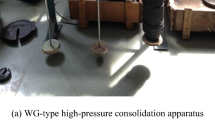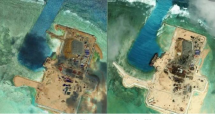Abstract
The particle breakage of porous and angular calcareous sand (CS) at the high-stress level is essential on compression feature but less quantified. In this research, a series of compression experiments and laser particle size analyzer tests were conducted under different ending pressures considering relative compaction and fine-grained soil (FS) content to investigate compression behavior and particle breakage of CS. The results indicate that the rebound curves are almost horizontal with a rebound index are between 0.0021 and 0.0054, and the FS content (smaller than 10%) has a little impact on resilience behavior. The irreversible plastic deformation is the main part of compression deformation. Besides, there exist two pressure thresholds of 400 kPa and 100 kPa corresponding to void ratio change trend when FS contents are smaller than 10% and reach 10%, respectively. Moreover, with FS contents increase from 0 to 10%, the moving distance of grading curves to the right becomes shorter gradually which suggests that the quantities of particle crushability decrease. FS can relieve stress concentration among CS that leading to less particle crushability. The combination of these factors including FS content, relative compaction, and axial loading has a complex effect on the relative crushability ratio. Both FS content and relative compaction can restrain particle crushability while axial loading could promote particle crushing. In addition, the relative crushability ratio has a negative linear relation with FS content and relative compaction. But, the relation between particle crushability ratios with axial loading can be described as a logarithmic function well. However, when relative compaction increases to a certain degree of 0.7, the influence of pressure on the relative crushability ratio is weakened. Similarly, the effect of relative compaction on the void ratio is weakened when the FS content is increased. Furthermore, there is a good negative linear correlation between the void ratio and relative crushability ratio.













Similar content being viewed by others
References
Alcerreca JC, Silva R, Mendoza E (2013) Simple settling velocity formula for calcareous sand. J Hydraul Res 51:215–219
Ata A, Salem TN, Hassan R (2018) Geotechnical characterization of the calcareous sand in Northern Coast of Egypt. Ain Shams Eng J 9:3381–3390
Einav I (2007) Fracture propagation in brittle granular matter. Proc R Soc A 463:3021–3035
Hardin BO (1985) Crushing of soil particles. J Geotech Geoenviron Eng 111:1177–1192
Jafarian Y, Javdanian H, Haddad A (2018) Dynamic properties of calcareous and siliceous sands under isotropic and anisotropic stress conditions. Soils Found 58:172–184
Ji L, Chiu ACF, Ma LJ (2019) Shear modulus of hydrate bearing calcareous sand-fines mixture. E3S Web Conf 92:04–002
Wang JB, Fan P, Wang M (2020a) Experimental study of one-dimensional compression creep in crushed dry coral sand. Can Geotech J 57:1854–1869
Jin W, Chen R, Wang X (2019) Effect of wood fiber on the strength of calcareous sand rapidly seeped by colloidal silica. Matec Web Conf 275(2):03006
Kargar SHR, Salehzadeh H, Shahnazari H (2014) Post-cyclic behavior of carbonate sand of the Northern Coast of the Persian Gulf. Mar Georesour Geotec 34:169–180
Ma LJ, Zeng LA, Wang MY (2018) Effects of size and loading rate on the mechanical properties of single coral particles. Powder Technol 342:961–971
Liu L, Liu H, Stuedlein AW (2019) Strength, stiffness, and microstructure characteristics of biocemented calcareous sand. Can Geotech J 56:1502–1513
Liu L, Liu H, Xiao Y (2018) Biocementation of calcareous sand using soluble calcium derived from calcareous sand. Bull Eng Geol Environ. 77:1781–1791
Lv Y, Li F, Liu Y (2017) Comparative study of coral sand and silica sand in creep under general stress states. Can Geotech J 54:1601–1611
Lv Y, Li X, Wang Y (2020) Particle breakage of calcareous sand at high strain rates. Powder Technol 366:776–787
Lv Y, Wang Y, Zuo D (2019) Effects of particle size on dynamic constitutive relation and energy absorption of calcareous sand. Powder Technol 356:21–30
Murthy TGDL (2007) Undrained monotonic response of clean and silty sands. Géotechnique. 57:273–288
Ni QTST (2004) Contribution of fines to the compressive strength of mixed soils. Géotechnique. 54:561–569
Rasouli MR, Moradi M, Ghalandarzadeh A (2020) Effects of initial static shear stress orientation on cyclic behavior of calcareous sand. Mar Georesour Geotec. https://doi.org/10.1080/1064119X.2020.1726535
Rui SJ, Guo Z, Si TL (2020) Effect of particle shape on the liquefaction resistance of calcareous sands. Soil Dyn Earthq Eng 137:106302
Salem M, Elmamlouk H, Agaiby S (2013) Static and cyclic behavior of North Coast calcareous sand in Egypt. Soil Dyn Earthq Eng 55:83–91
Shi J, Haegeman W, Andries J (2020) Investigation on the mechanical properties of a calcareous sand: the role of the initial fabric. Mar Georesour Geotechnol. https://doi.org/10.1080/1064119X.2020.1775327
Smith DA, Cheung KF (2003) Settling characteristics of calcareous sand. J Hydrau Eng 129:479–483
Sun W, Jiang Y, Liu JZ (2014) Analysing the micro structure of sea sand concrete. AMM. 584-586:1076–1080
Tan F, Wang X, H M (2017) AE test of calcareous sands with particle rushing. Pol Marit Res 24:118–124
Wang Y, Ma L, Wang M (2018) A creep constitutive model incorporating deformation mechanisms for crushable calcareous sand. Arab J of Geosci 623 https://doi.org/10.1007/s12517-018-3982-8.
Wang Y, Ren Y, Yang Q (2017) Experimental study on the hydraulic conductivity of calcareous sand in South China Sea. Mar Georesour Geotec 35:1037–1047
Wang YJ, Han XL, Jiang NJ (2020b) The effect of enrichment media on the stimulation of native ureolytic bacteria in calcareous sand. Int J Environ Sci Technol 17:1795–1808
Wei H, Zhao T, Meng Q (2018) Experimental evaluation of the shear behavior of fiber-reinforced calcareous sands. Int J Geomech 18:4018175.
Xiao P, Liu HL, Stuedlein AW (2019) Effect of relative density and biocementation on cyclic response of calcareous sand. Can Geotech J 56:1849–1862
Yang C, Jiang H (2020) The comparative study of single pile bearing characteristics in calcareous sands foundation and quartz sands foundation based on model experiment. IOP conference series Earth and environmental science. 455:012086.
Yu FW (2018) Particle breakage in triaxial shear of a coral sand. Soils Found 58:866–880
Yu FW (2017a) Particle breakage and the drained shear behavior of sands. Int J Geomech 17:04017041
Yu FW (2017b) Particle breakage and the critical state of sands. Géotechnique 67:713–719
Yu FW (2019) Influence of particle breakage on behavior of coral sands in triaxial tests. Int J Geomech 19:04019131
Zhang J, Sun Y, Cao J (2020) Experimental study on the deformation and strength characteristics of saturated clay under cyclic loading. Adv Civ Eng 2020:1–9
Zhao Z, Qiu Y, Wang M (2019) Effects of strain rate and initial density on the dynamic mechanical behaviour of dry calcareous sand. Shock Vib 2019:1–10
Funding
This work was supported by the National Natural Science Foundation of China (Grant No. 41731281) and Guangdong Basic and Applied Basic Research Foundation (Grant No. 2020B1515120083).
Author information
Authors and Affiliations
Corresponding author
Appendix
Appendix
Grading curves of tested samples before and after one-compression tests with different FS contents and relative compaction under axial loading (100, 200, 400, 800, 1600, 3200, and 4000 kPa) are shown in the following: a P = 100 kPa, b P = 200 kPa, c P = 400 kPa, d P = 800 kPa, e P = 1600 kPa, f P = 3200 kPa, g P = 4000 kPa
Rights and permissions
About this article
Cite this article
Li, X., Liu, J. One-dimensional compression feature and particle crushability behavior of dry calcareous sand considering fine-grained soil content and relative compaction. Bull Eng Geol Environ 80, 4049–4065 (2021). https://doi.org/10.1007/s10064-021-02160-2
Received:
Accepted:
Published:
Issue Date:
DOI: https://doi.org/10.1007/s10064-021-02160-2








